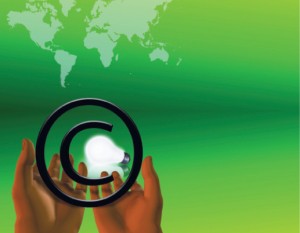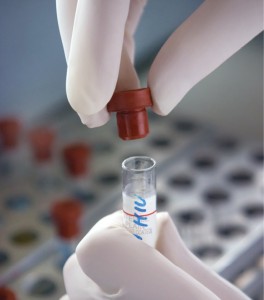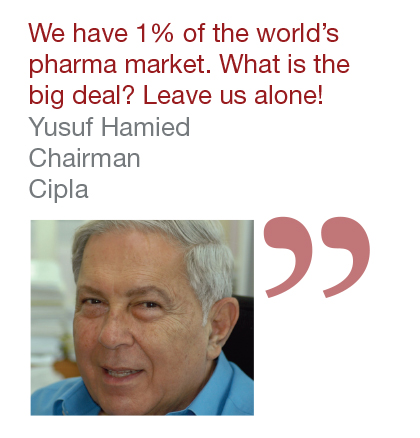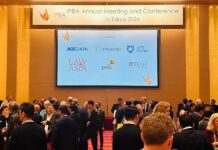Cipla’s chairman Dr Yusuf Hamied talks to India Business Law Journal about the country’s intellectual property regime, the lack of specialization in the legal profession and his battle against ‘Big Pharma’ to provide cheap drugs to the poor
India’s output of generic drugs has lowered the price of essential medicines around the world. The industry has thrived on the back of a longstanding unwillingness by the Indian government to grant patents for pharmaceutical products. The introduction of India’s new Patent Act in 2005 changed the situation, creating serious hurdles for the country’s generic producers. However, tough thresholds for acquiring patents, particularly section 3d of the Patent Act, which prevents the patenting of incremental innovations and was used successfully to block Novartis’ attempt to patent its leukemia drug, Glivek, may give generic manufacturers some breathing space.
One of the leading proponents of India’s generic drugs industry, Cipla’s chairman Dr Yusuf Hamied, believes India’s patent regime leaves a lot to be desired. In an exclusive interview with India Business Law Journal he discusses his fight against monopolies and argues that India is far from being a significant player in the global drugs market.
You must be a
subscribersubscribersubscribersubscriber
to read this content, please
subscribesubscribesubscribesubscribe
today.
For group subscribers, please click here to access.
Interested in group subscription? Please contact us.
你需要登录去解锁本文内容。欢迎注册账号。如果想阅读月刊所有文章,欢迎成为我们的订阅会员成为我们的订阅会员。
IBLJ: There have been a number of new judgments related to intellectual property protection that Cipla contributed to. What do you think about the country’s IP legislation?
YH: I’m told the judges and the people at the patent office have been trained by the Americans so they will probably be blinkered. But I want to ask a specific question: How is it that they have given so many patents in healthcare in such a short period of time? Are the patents properly examined? I saw a figure the other day and I was very, very surprised about how the patent office could have gone through and studied, scientifically, so many patents. Just because a patent is granted in Europe or America does not mean it passes Indian patent law, which is different.
Particularly with this new clause in the [Indian Patent Act]: section 3d. It is a very interesting clause. There are 7,000-odd patents in the mailbox. Those patents were put in when 3d was not there. Now that 3d is there, maybe 50-60% of those patents are not valid. Why don’t you voluntarily withdraw [them]? It is only fair that those who have put in those patents should now revise them.
IBLJ: Maybe it is like a lottery. Why would you throw away your ticket if you just might win?
YH: That is the whole question. For example, a case in question was Glaxo’s patent on a drug combination of AZT and lamivudine, which is one of Glaxo’s largest selling drugs. To us, it was not patentable in India. [There was] no novelty. We challenged it. The day before the judgment was due, Glaxo withdrew the patent. But they [fought] right to the end.
We see time, energy, money – everything – hoping that [the patent] will come through. And if it doesn’t come through, [there is a] last minute withdrawal [because] if they lose the case, there are repercussions outside India.
IBLJ: Do you fight patent applications that won’t pass the Indian standard?
YH: How many patents can I fight? If there [were] 5,000 patents in the last year in healthcare, I can’t fight 5,000 patents. I can fight one or two. The ones that I am fighting today, or Cipla is fighting, are the ones where we generally believe that there are grounds to fight. We are taking on patents that are borderline [and] when we feel there is no novelty.
IBLJ: Should there be fewer patents?
YH: No single product should have more than a few patents, the basic patents where you are describing and giving the substance. Now, suppose that is made in six steps. Not only are you patenting as a product the final drug, but all the intermediate steps. Then you are patenting new processes for those intermediates that go beyond the expiry date of the end product. [This is an attempt at] evergreening. Once the end product goes, all the other intermediate products should also go.
But that is not what my whole theme is right now. I feel that today I can fight, like we are fighting Roche, on two or three products. We are in court with Novartis [and] Gilead. These are cases where Cipla believes we have a very good case. Where I feel we have no chance, we are not fighting.
IBLJ: Do you challenge patents in other jurisdictions?
YH: We have challenged one patent in England and that was a historic judgment.
IBLJ: Do you think politics gets in the way of the law?
YH: Politics and regulating shouldn’t go together but they do.
IBLJ: The media, when they report on IP cases, publicize the political affiliation of the lawyers involved. Is politics a consideration for you?
YH: I never consider that. I only [believe] in my personal opinion as a scientist and knowing a little about the patent laws in India, [I consult] various legal people, if I feel I have a case. Putting two things together is not novelty. And yet, here, you are getting cases left, right and centre.
IBLJ: Are the changes to India’s IP regime helping or hurting the industry?
YH: I have given many, many speeches on this subject. In 1972 we changed our laws because we felt at the time that India’s major needs were food and health. And only in these two areas [did] we change the laws. We said you could not have a product patent, only a process patent. And then in 1995 they revoked it. So we are going back now to an era of monopoly.
I have been vehement against monopoly. All my talks in the past two years have been on [that] subject. I have nothing against patents, only against monopoly. We are saying that none should be denied access to medicines at affordable prices. We cannot have the same rules for 600 million people in the developed world and 3 billion people in the third world. You have to differentiate. The only way to differentiate is [to have] no monopoly.
IBLJ: What are the options?
YH: What the third world requires, in particular countries like India, is what Canada did in 1969. They passed a bill called S91, which was law until 1992 when they joined NAFTA [the North American Free Trade Agreement]. It says Canadians can copy any drug they want and pay a 4% royalty to the innovator or the inventor. What happened in 1969 when Canada passed it? Americans didn’t object. Europeans didn’t object. The world didn’t object. If it was good enough for the Canadians, why isn’t it good enough for the third world? They are suddenly going after Brazil, Thailand and anybody who is saying, “look, we accept patents, what we are saying is that we don’t want a monopoly. And if you have a valid patent, we are willing to pay you a royalty of 4%”; 70% of the leading drugs in the world were not invented by the companies that market them.
IBLJ: Can drugs from big pharma reach all of India?
YH: They can only work in an aura of monopoly. That is why they gave up India in 1972. We didn’t reach this position overnight. It took 10 or 20 years for Indian companies to grow. Right now, we are in a period of stabilization. When we start going down, the multinationals will come up. The cutoff time, to me, is 2012 or 2015 when [patents for] older drugs die and newer drugs [which doctors will want to use] come into the market. And that is when I say that the Indian government has committed selective genocide in India.
IBLJ: Does Cipla produce its own drugs? Does it do research and development?
YH: What is R&D in pharma? It consists of two parts: concept and molecular manipulation. By concept you mean the first beta blocker, the first tranquilizer, etc. The American government spends US$50 billion on conceptual research in health care alone every year. Stanford, Yale, NIH, Harvard Medical School, Berkeley, you name it. US$50 billion.
The molecular manipulation of the original is not that expensive. You can do it at home on a computer. Put it there and ask what are the other structures related to this that could, perhaps, be biologically active? And you get a whole [list] all on the computer. And you synthesize them. And God willing, one of them becomes active. And they call it a new chemical entity.
The money that is spent on R&D is how to remain evergreen. That is where the major money is spent. How many patents do you require for [Ciproflaxacin]. One, two, three, five? There are 500 patents. And on the intermediaries of Cipro, how you can block Cipro and how you can extend the life of Cipro. People say they spend on [the] R&D of new chemical entities. They don’t. They are changing the existing [entity]. That twitching, every drug company does, including Cipla.
IBLJ: How do you explain this to the public?
YH: It is very difficult to explain. I would differentiate between conceptual and what is called “me-too” research.
Do people do conceptual research in India? No way. We all do, in a limited way. But you can’t be successful in marketing. I don’t have a worldwide marketing organization. What am I going to market? The product acceptability is not there.

In my 40 years I have come out three times in India with new products. All three products failed. Then I go to the doctors here in India [and] say: “Doctor, how come you are not using this product of mine?” And they say: “Dr Hamied, if this product of yours is as good as you say it is, how come Pfizer or Glaxo have not brought it out ahead of you?”
[Let me] give you another example, Italy. Until 1984, it had no patents. In 1984, when they joined the European Union, they brought in patents. Then what happened? Until 1984, the indigenous Italian companies were ruling the roost, like all of us. They brought in the patents in 1984 and, 20 years later, have the Italians invented one new product? No. And they were good scientists. The three leading Italian companies in 1984 were Pharmaitalia, [Gruppo] Lepeti, [and] Carlo Erba. They don’t exist any more.
IBLJ: Do you think the same will happen in India?
YH: I have made a prediction that by 2020, Ranbaxy, Dr Reddy’s, Cipla, will not exist. We won’t exist as is. (This interview was conducted before Ranbaxy’s takeover by Daiichi Sankyo was announced.)
IBLJ: Will they get bought out? Sell out? Or will they go out of business because they can’t compete?
YH: A combination.
IBLJ: Are you going to get bought out?
YH: Who knows? Not in my lifetime.
IBLJ: You are not going to sell?
YH: No.
IBLJ: Why do you think the government is bringing in changes to intellectual property legislation?
YH: If you ask the Indian government, they have a ready answer: “We can’t upset the international community.” I said: “But, gentlemen, the patent law is a national law. [How] are you upsetting the international community when India’s overall trade internationally is – it used to be 0.5% – I think today it is 0.7% or 0.8% of world trade? We’ll reach 1% by 2010. What is the big deal? Who is benefiting?”
In pharma, the total world trade is US$700 billion. India’s [is] US$7 billion.
IBLJ: Is the generic market in India larger?
YH: In value [it is] nothing. In volume, yes. We have 1% of the world’s pharma market. What is the big deal? Leave us alone!
IBLJ: But are the multinationals looking not at what it is now, but at what it could be?
YH: They want a monopoly.
IBLJ: Do they want a monopoly 15 years from now and believe this is the time to get in?
YH: That is what they are doing. They are trying to establish [their] position.
IBLJ: You were talking briefly about marketing. Do you have to deal with counterfeits?
YH: Yes, in a big way.
IBLJ: Have you been hurt by them?
YH: Yes. I’m told that 25% of all the drugs sold are either counterfeit or fake. We are selling our drugs, essentially, to people like [Médicins Sans Frontières]. We are not selling them outside. We are selling them to UNICEF, NGOs and governments.
IBLJ: Is developing an IP regime your focus?
YH: I was asked a few years ago to come to Delhi for a meeting to discuss pharma R&D. Government people sitting on one side, industry people sitting on the other. And this is what I said: “The creation of a new chemical entity involves a multitude of sciences. You have to be a jack of all the sciences and master of all the sciences otherwise you can’t succeed.”
Step one involves chemistry or biotechnology, fermentation or plant chemistry, where you isolate or you make a chemical. In the chemistry part, we Indians are okay. We can make a chemical. The next step is [to determine whether] that chemical [is] toxic or non-toxic. Then I raised my voice and I said: “There is not one laboratory in India whose toxicology results are acceptable internationally.” And what I said then holds true today.
Suppose I cross that hurdle. What’s next? Pharmacology. There is not one pharmacology laboratory in India whose results are accepted internationally, even today.
I cross that hurdle. What have I to do next? It’s what is called pharmacokinetics. Is the drug to be [administered through] tablets, or by injection, or given application [and] what should be the dosage? Perhaps in that little area, pharma companies like ours could do something. Suppose I cross that hurdle, I have to do trials [on] human beings. The results are not accepted internationally.
So what are people talking here? They are doing not what I call R&D but they are doing PR&D: public relations R&D. All the compounds that they have made so far are what I classify as “me-too”.
I’m also doing R&D but my focus is different. I can’t compete. At the very early stages, one or two Indian companies are trying to compete. Fine. Good luck to them. I am competing in the “me-too”. How can I tweak this? How can I make this into a better matter? Reverse engineer. And we take a lot of patents. I think we have about 200 or 300 patents by now, granted or in the pipeline.
IBLJ: How long before there is a brand new, India-developed molecule that goes from the early stages all the way through?
YH: It cannot happen. Has it happened in Japan? No. Has it happened with the Chinese? No. Why? Where are you going to sell? I don’t have the worldwide marketing organization to sell. I have to go with the begging bowl to those guys. So they are in control, I am not. There are about 20 companies in the world that are in control. Let’s face facts. Have you ever heard of a Russian product in the market? No. Or a Japanese product in the Western markets? No.

I gave evidence in parliament in India in 1993. They asked: “Why can’t India do R&D like it is being done abroad?” And I said: “Sir, you have two alternatives. One is what we are doing today: Giving our medicines in India at affordable and accessible prices.” That is my whole theme.
Then I said: “If you allow me to sell my products in India at the same prices at which they are being sold in America, rupee to the dollar, then I can do fundamental research. I can’t do it without that.”
Do you know the total R&D budget in India? In the year 2005, the total was US$3 billion. Public and private sector included and all industries: Space, nuclear, everything. One company alone, Pfizer, spends US$7 billion a year.
Cipla spent last year US$50 million in R&D. I don’t have the market. With a US$1 billion turnover how can I compete with a company that has US$100 billion turnover?
IBLJ: Is the gap getting bigger?
YH: I’ll tell you what the difference is. We might be 1% in value but they are mixing up the issue of value versus volume. If the world pharma business is [worth] US$700 billion, India is 1% by value but 12% by volume. China is 1.5% by value, but maybe 15% by volume. India and China [account for] one third of the volume of the world in actual pieces of drugs sold. That, to me, is quite significant.
If tomorrow, India and China decide not to export pharmaceuticals, America would be a dead duck. The foundation and the heart of the pharma industry are the raw components and you are more and more dependent these days on China. The Indian pharma industry would shut down if it wasn’t for China.
IBLJ: How do you explain all these facts to the politicians, the policy makers?
YH: I try. I’ll give you an example of what happened to me. I give this medicine, a drug that stops the transmission of AIDS from mother to child, and I give this free all over the world. Totally free. I showed it to an Indian politician several years ago. He looked at it and said: “You give this free?” And I said: “Yes, sir, I give this free all over the world.” You know what his response was? “You must have an ulterior motive.” So I laughed at him and said: “I don’t have an ulterior motive. I want to do some good before I die.” You see the mindset. I’m not going to take all this with me when I die.
IBLJ: Do they understand the challenges that go into research?
YH: No. Look at the infrastructure today given by the government. What I’m finding today, as far as Cipla is concerned [is that] I get more appreciation and respect outside India than I do in India. Here, everybody wants to put a knife in me.
IBLJ: What have your experiences been like working with lawyers in India and abroad?
YH: You see, to be a patent lawyer is a specialty. Slowly, some of the Indian lawyers are specializing in patents. It is a big, big business.
IBLJ: It is difficult to find a lawyer or judge that knows all the ins and outs of a specific field?
YH: Nobody does.
IBLJ: How do you deal with that?
YH: It is very difficult, but I have to take it as it comes.
IBLJ: What happens to Cipla in the future, 10 years from now?
YH: I don’t look so far ahead.
IBLJ: Five years from now?
YH: I think five years is too far away.
After this interview took place, Daiichi Sankyo of Japan announced its takeover of Ranbaxy, one of Cipla’s principal competitors (see Prescription for success? on page 30). Hamied describes the deal as “a wake-up call for the Indian government.
“[The government] have to protect their indigenous industries,” he argues. “They don’t provide any of the necessary infrastructure to protect national industries. The prices of raw materials are going up but they want to control the prices of the final product.”



























